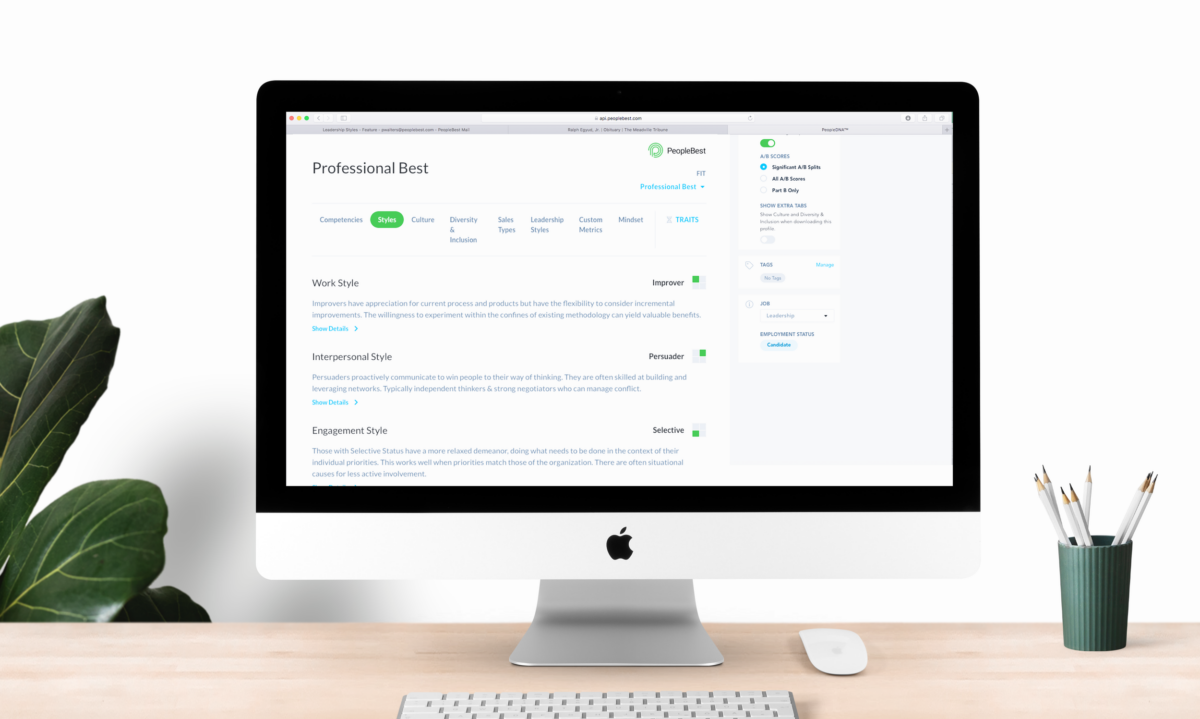
Don’t Blink! The Difference Between 1st and 5th Place in Business
Guest Post by Tim Barry – I am a speed freak. A professionally trained driver, I’ve had an Audi R8 up to 161mph on a

Guest Post by Tim Barry – I am a speed freak. A professionally trained driver, I’ve had an Audi R8 up to 161mph on a

Did you know that a whopping 83% of organizations face a skills gap in their workforce? That’s according to a recent survey from the Association for Talent Development, which also reported that 78% of employers said they expect to face skills-related issues in the future.

Employers that want to keep their leaders — and especially the women in their managerial ranks — know their mission: They must provide ample opportunity, and the training to go with it.

That saying — “style over substance” — makes an important point. Sure, a rocker’s getup is part of the package, but no one wins a Grammy on an outfit alone.
When it comes to Leadership Styles, the same lesson applies. Leaders can’t succeed on swagger. But I believe style does have something to do with their success. In fact, when leaders discover their style, they unlock greater “substance” and lead with improved agility and heightened confidence.

We’re well into the first quarter of 2023, and that means we have a good idea of the trends that will shape the year unfolding before us.
I like to think about the trends marking the job market for two reasons. As an employer, I want to stay on top of the evolutions we’re seeing from big employers — and the economy. As a leader in the human capital space, my focus is to assess trends in how people are impacting the performance of companies.

A new year is upon us – Happy 2023! Now is the time to set new goals, find new challenges and take new opportunities. But how do we discern what we want to achieve? How do we wade through the tempting and the flashy and set our sights on progress that really matters?

Bring your whole self to work – that’s what many companies are asking their employees to do in a push for greater authenticity in the

As employers, we’re always trying to make decisions based on evidence. We want to hire the candidate who hands in the best resume. We want to promote the worker who offers the best track record. Companies have long operated this way.

This year started with the Great Resignation. The “quiet quitting” trend arrived this summer. And now 2022 is ending with a probable recession. In other words? It’s been a tough 12 months. Many of this year’s employment trends have focused on workers’ unfulfilled needs. Employees felt unheard, underpaid and underdeveloped, so they sought out new opportunities.

In-person and remote employees require more flexibility, and these days, they can find it, making the war for talent formidable. How does an organization face this changing reality? This weighty matter falls on the shoulders of leadership. Business leaders must build their teams, find ways to encourage collaboration and engagement, and build trusting relationships among team members. And all the while, they must manage a staff who may seldom step foot in the office.

Many organizations are pushing to make hiring more speedy. The craze has led employers to rethink their hiring processes — what a great opportunity for improvement.
I believe that the standard candidate experience is not just stale, but broken. We ask candidates to sum up their experience on a piece of paper, sit through a nerve-wracking interview, and then wait weeks as we deliberate on a yes or no.

With so much attention on the workers who say “sayonara,” there’s good reason employers are asking the big question above. Why do employees quit? Is something pushing them out? Or is the grass really that much greener on the other side?

There are a lot of tools on the market right now that claim they can assess candidates and workers. But how do you identify the tools that will give you the insights you need to find
the right workers and make sure they thrive?

High-profile employers are making headlines as they decide whether to call workers back to the office or leave them at home. Remote work is no longer an option at SpaceX, for instance, after Elon Musk ordered employees to spend a minimum of 40 hours in the office each week.

A recent report from Mercer found that employees deeply need mental health support. One in five respondents worldwide said they experience high or extreme levels of stress on a daily basis. Those numbers rose to 25% among U.S. workers.

What role does feedback play in an organization? Surely, it’s important to guide employees throughout their tenure, ensuring they don’t just log hours, but learn and grow. But feedback is tricky to get right. A recent essay in the Harvard Business Review featured two business leaders’ musings on the subject: “The research is clear,” they wrote. “Telling people what we think of their performance doesn’t help them thrive and excel, and telling people how we think they should improve actually hinders learning.”

PeopleBest offers over 100 job templates and 300+ competencies to quickly use what works for your job, or your can create a unique set that reflects your organization’s critical success factors.

As the Great Resignation swept across the business world this year, companies reached for new strategies to boost retention and slow turnover. Organizations rolled out enticing new benefits, upped employee appreciation measures, and handed out competitive counteroffers.

Did you know, workers are 80% more likely to improve in their jobs when they see managers making bringing their A game, according to software developer Humu. Humu’s report also revealed that employees felt more support and showed greater resilience when they were working under good managers during the pandemic.

We’re more than half-way through the year, and I’ve got a scary question for you: Where are you with your annual review? Have you thought about it since you walked through it with your boss just before the holidays? Have you made any progress on the goals you set in January?

Was workplace collaboration a casualty of the pandemic? Seventy-five percent of employees say that teamwork suffered greatly since the onset of COVID-19. Remote operations hampered team meetings. Zoom glitches interrupted strategy sessions. Social distancing rules ruined plans for drinks and dinners.

When you get bad news at work, what do you do? Your response to a tabled project or canceled event may illuminate more than you think. In fact, our ability to process surprises and disappointments predicts other indicators of success.

In workplaces across the globe, the next generation of leaders is arriving. It is estimated that 75% of the workforce will be millennials by 2025. By that date, millennials will also out represent boomers in leadership roles. Do these up-and-coming leaders have the skills to lead? PeopleBest is measuring critical intelligence to help organizations ensure they do.

We’re officially into the third quarter now, and the end of the year will arrive sooner than any of us will believe. How are those beginning-of-the-year goals doing? Are they starting to feel out of reach? Do you have a ways to go before counting them accomplished?

Today, you’re focused on the roles you must fill to survive the next six months. But if you let your focus rest solely on today’s must-have roles, your business will suffer in the future. Let me explain. In our increasingly digital world, it’s essential leaders take the time to hone a tech-savvy workforce. A global skills shortage will cause an estimated 85 million jobs to go unfilled by 2030.

Bring your whole self to work — that’s the commandment every employee-friendly company wants workers to live by. Bring your cat to team meetings. Post photos of your trip to Barbados on Slack. Host a brown bag on how to create the perfect cheese board.

There’s a great debate going on right now among employers around the globe. To work remotely or not to work remotely — that’s the question. The stakes are high on either side. On the one hand, employers have expensive real estate that’s going totally unused. And they know collaboration could use a boost from in-person work.

Jobs have shifted across the board and at an even faster pace than pre-pandemic. There have been losses due to closures and automation. Most jobs today require some level of technical skill to perform duties. Learning & Development professionals have upskilling resources among their top goals.

June is Pride month here in the U.S., and many employers are celebrating by re-casting their logos in rainbow. Don’t get me wrong — a striking change to an emblem as steady as a logo can signal support. But the move rings hollow if it’s not matched by an underlying framework of inclusion and care.

The office is a complicated place for managers right now. First of all, that word “office” — what does it even signify today? It’s more than the space between four walls cement walls. It now encompasses corporate-owned locations, coworking spaces, and people’s home offices, living rooms, and dining room tables.

Today’s teams are more diverse, dispersed, digital and dynamic. This creates a growing imperative to move information and energy through the organization and reduce friction that slows progress. How do leaders build trust and attentiveness in their teams on what matters? How can the team stay ‘on point’ during strategic shifts?

With so many companies reeling over the effects of the Great Resignation, leaders are considering all kinds of strategies to help them find and keep good talent. A focus on finding and keeping good talent is a natural response when you’ve got open roles that desperately need filling. But I’d like to point out that the phenomenon embroiling the job market is called the Great Resignation, not the Great Recruitment.

In many workplaces, teamwork ain’t what it used to be. The pandemic replaced good old fashioned meetings with Zoom calls, Slack standups and other tech-enabled solutions. Those fixes got us through a terrible time, but they couldn’t reproduce the camaraderie and collaboration of in-person coworking.

Companies that teach workers to understand their skills as scalable are in a much better position to retain talent. Workers need to feel that their work connects to their personal passion — it motivates them, and it impacts the bottom line.

If you take resumes and cover letters out of the recruiting equation, you have to find something to take its place. That something should provide data-driven insights into candidates’ skill, potential, and passion.

The PeopleDNA™ Profile identifies candidates’ strengths in critical job requirements. It enables hiring managers to make informed decisions on the best candidates for the job and who will thrive in the culture.

Why do employees quit? It’s a question that keeps business leaders up at night, and it’s also a question that’s hard to answer. Thankfully, research helps us pinpoint a couple of the most common factors that cause employees to quit.

How do you shift skill, performance, and expectations for an entire group of people? What are the hallmarks of a high-quality workforce? How do employers develop those traits in their employees? These are questions every business leader asks themselves, especially in this tricky employment landscape of 2022.

April 22nd is Earth Day, so this question might come to mind as you plan any related events. The planet and our workforce are obviously interconnected, but celebrations like Earth Day challenge employers to dig a little deeper to determine how people management and planet management align.

More than 4.3 million workers quit their jobs in January, and that was a slight improvement from the record-high 4.5 million who quit in November. The Great Resignation is affecting employers in virtually every industry, leaving recruiters and hiring managers in the lurch as they attempt to maintain even operational staffing levels.

The mass exodus from the office challenged businesses’ flexibility, priorities and workplace culture. Beyond the initial adjustment of creating an at-home work space, workers had to establish communication with supervisors, teams and customers. And after the new norms took root, the focus shifted to sustaining or enhancing performance in a new and changing environment.

With World Autism Awareness Day just behind us on April 2, I want to take a moment to speak to a topic that’s often left out of discussions about diversity, equity and inclusion: Neurodiversity. We can start supporting neurodiverse individuals by stepping away from rigid practices that may eliminate neurodivergent applicants from our candidate pools.

March 31 marks Equal Pay Day. Ninety days into 2022, the date signifies how many days women must work to earn the amount of money men earned in 2021. The day, set by the National Committee on Pay Equity each year, calls attention to the pay gap that exists between working men and women in the U.S. According to the Bureau of Labor Statistics, women made 82% of men’s annual earnings in 2020.

Organizations across the globe are attempting to be more inclusive. That’s a lofty and often nebulous goal, leaving many with a big question: Where do we start? We’ve compiled a couple of tips that will help you make your holiday plan more inclusive.

Do you know who your workers are?
I know you can name them. I know you can recite their titles. I know you’ve got a general idea of whether they’re a superstar or a headache. But that’s not really what I’m asking — I want to know if you actually get them.

In celebration of International Women’s Day, we want to discuss how workplaces can #BreakTheBias and help women thrive at work and beyond.

Job seekers have more options to consider now more than ever, making the labor market a true challenge for employers. Information is abundant about companies, and candidates will compare and contrast job opportunities. As they search, they’ll assess for culture. Candidates are looking for workplaces that believe in values such as customer service, professional growth or collaboration. Leaders, meanwhile, have a vested interest in evaluating how well their employees connect to stated values.

Employee appreciation day is Friday. Do you have a plan? It’s an important question. Don’t let yourself be the workplace version of the poor saps standing in line for self checkout at 5 p.m. on Valentine’s Day, holding a sad bouquet of wilted roses. But there’s a more important question out there: How do you make sure your employees feel recognized for their effort when they head home for the weekend, not only this Friday, but every Friday?
Our approach to talent is reflected in our name: We want you to find the best people for your company, and then we want to empower you to treat them the best you can.
PeopleBest offers a path forward. In this white paper, we will explore three ways a holistic talent system powers your people decisions.
Part 1 — Learn
Envision your talent goals and learn how a system can help you achieve them.
Part 2 — Discover
See how talent systems use data to generate insight.
Part 3 — Find
Learn to assess a talent system’s functions and judge for success.

When workplaces encourage employees to forgo the occasional sick day — even if it’s for a mild head cold — they tell workers that their health comes second. Somehow, the COVID-19 pandemic put the sick day in danger. That may sound impossible — it’s definitely ironic. But emerging research says it’s true. HR tech company Beamery recently reported that 39% of workers are more likely to work through sickness from home. And a quarter said they believe sick days themselves are a thing of the past.

Behavior data will tell you what’s going on and what may be coming next. Regular people analytics? It won’t get you there. With workers leaving their jobs in droves, employers must do whatever they can to recruit and retain the best talent. Data can help them do that, but the numbers have to paint as accurate a picture as possible.

There’s good news for everyone who wants to do a little better in 2022. A recent study found that digital tools were so effective in helping users change their behavior traits, friends and family noticed their progress.

PeopleBest now measures the six leadership styles identified by Daniel Goleman in Emotional Intelligence. The resulting insights equip organizations with the information they need to hire the best candidates and develop those they bring on board.

What are the factors that allowed people to get through the enormous challenge that was and is the COVID-19 pandemic? When the coronavirus began its first sweep through the U.S., the country transformed, almost overnight.

Awareness is the first and essential stepping stone to change. Without it, effort and action make way for frustration — not progress. What role does awareness play in mindset? Mindset is often perceived as passive and untouchable. There’s some truth in that idea: childhood, education and personality all work to define our mindset.

Work doesn’t have to be a series of draining group projects. With the right tools, teams can share responsibility, work efficiently and maybe even enjoy each others’ company. The formula sounds simple, and it is: Self awareness creates the opportunity for change. But there are three key steps teams must follow to make the journey from knowledge to action.

Self-awareness is the cornerstone to emotional intelligence. To be strong in self-awareness is to be able to adjust one’s thinking and strategy based on a situation. Some experts believe that being self-aware is the meta-skill of the 21st century. It allows workers to course correct, influence, befriend and lead.

PeopleBest System measures eight Mindset competencies. Fixed mindset is a frame of mind that seeks validation to ensure ideas are heard and efforts are noticed. Someone with a growth mindset has more freedom, free to break down limiting beliefs and create a path forward.

Companies are stuck in the traditional hiring process. Future-focused employers are headed another way, and you can join them.

Combining the ‘key’ ingredients to bring your workers together. When the coronavirus swept the globe, companies could no longer offer the perks that once defined their culture. Their absence forced the question: What is our office culture now?

As employers grapple with The Great Recession, they must identify the employees who are poised to leave.

Part One: Learn Employers are facing historic challenges when it comes to talent. Getting workers in the door is a difficult task in itself. Then

When it comes to hiring, measuring for behavior is much more effective than measuring for personality. But there are other factors at play when it comes to getting the most out of your data.

In this blog post, PeopleBest CEO, Jim Hunter makes the case for why personality tests are insufficient when it comes to hiring and finding new talent.

More and more people are turning toward tools to help prevent making bad hiring decisions. But if you don’t take into consideration these 4 things, the tool isn’t going to help prevent that.

Diversity and inclusion are one of the most important tenets of hiring and AI is actually designed to uphold them—not undermine them.

When it comes to hiring, what you measure matters. When you’re looking for the right things, you open up a world of possibilities.

Before you invest in a hiring tool, ask yourself if it has these four critical attributes. If it doesn’t, it’s likely not the tool for you.